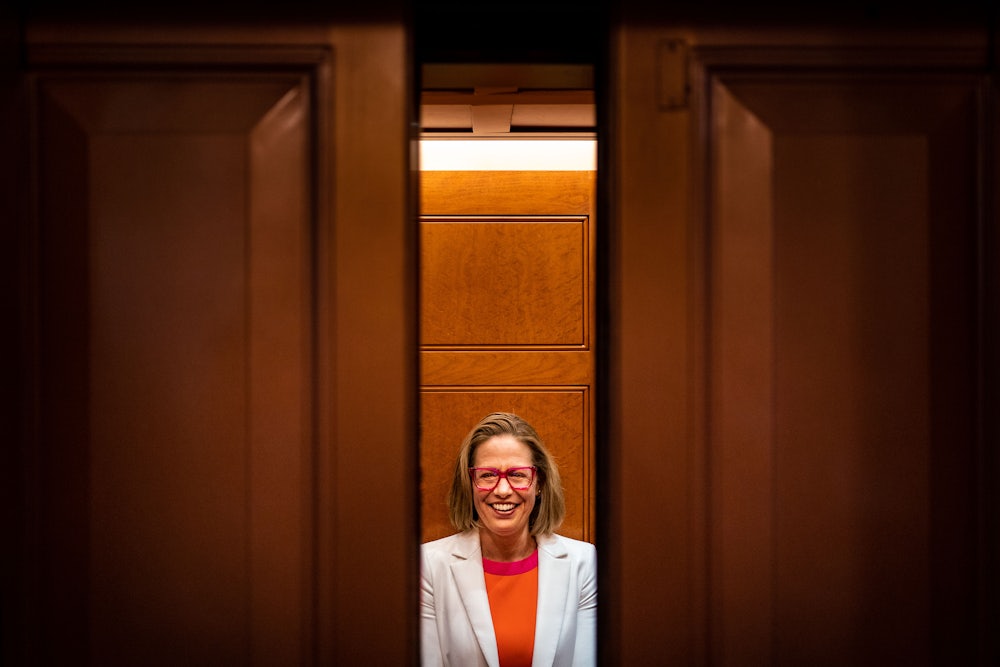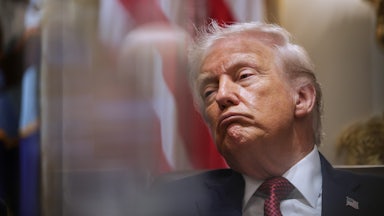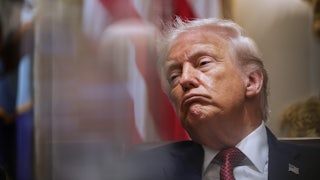For years, reporters have puzzled over one of Washington’s most pressing mysteries: What does Kyrsten Sinema actually believe? A narrow Democratic majority during President Joe Biden’s first two years in office made the Arizona senator extraordinarily powerful: She and West Virginia coal baron Joe Manchin could basically hold out for whatever they wanted. But Manchin’s beliefs were hardly shrouded—he wanted pork for his home state, protections for its environment-destroying industries, and to make sure nothing changed too much or too fast. Sinema was another matter altogether.
She favored loud, garish dresses that somehow only made her seem more unpredictable. She didn’t explain herself to the press or to her constituents. Her voting record largely made no sense. She would block anything for any reason. She didn’t want to raise the minimum wage in a Covid-19 relief bill but never said why—and instead killed it by cosplaying as John McCain. She stalled passage of the Inflation Reduction Act, a climate bill, because she was worried about the repeal of the “carried interest loophole”—even though she had never previously uttered those words during a legislative session. She spent months stymying the administration’s “Build Back Better” bill without ever saying why.
Confusion abounded. Was Sinema stalling the Democratic agenda—and constantly advocating on behalf of corporate interests—because she was planning an exit strategy as a lobbyist? Did she just really like helping rich people? Or was she upset that progressives were mean to her, and decided to get her revenge? Or perhaps she was just really bad at understanding polls, and the aforementioned moves—plus her party affiliation change last year to independent—were all a ploy to keep her seat?
Two new magazine profiles of Sinema attempt to grapple with the mystery. The biggest takeaway from both, however, is simply that she is running. Not for president—that would be crazy. But it’s clear from these articles, in The Atlantic on Saturday and The New York Times Magazine on Monday, that Sinema is intent on fighting to keep her seat despite facing a three-way battle in 2024. And she’s doing something she rarely does (talk to the press) to try to make her difficult path to reelection a little smoother.
Sinema herself bats away the existence of any mystery at all. Asked point-blank by The Atlantic’s McKay Coppins to explain what exactly ties together her weird votes, she shows little interest in conveying a political compass:
I ask her if there’s any ideological through line at all that explains the various votes she’s taken in the Senate. She thinks about it before answering, “No.”
She says she’s guided by an unchanging set of “values”—she mentions freedom, opportunity, and security—that virtually all Americans share. When it comes to legislating, Sinema sees herself as “practical”—a dealmaker, a problem solver. And if taking every policy question on a case-by-case basis bewilders some in Washington, Sinema says it’s just her nature. Even in her private life, she tells me, she’s prone to slow, painstaking deliberation.
This is both plausible and a bunch of nonsense. Sinema may have no deep-seated ideological core—her voting history suggests as much. Saying that her votes are threaded together by “freedom, opportunity, and security” is both Beltway pabulum and something that Sinema may earnestly believe. Regardless, it doesn’t actually mean anything: She’s just saying stuff in the absence of a tidy or compelling argument.
Sinema is undoubtedly setting up to run for reelection as a pragmatic dealmaker. “Nothing she said in our conversations left me with the impression that she was putting a few final touches on her senatorial legacy on her way out the door to the private sector,” writes Robert Draper in the Times. “At the same time, Sinema—whom even her closest friends describe as calculated, and who described herself to me as ‘very intentional’ and ‘a planner’—almost never telegraphs her strategy.” Perhaps because he was unable to divine that strategy, Draper spends much of his profile depicting Sinema doing the work of legislating: winning over Republicans, putting together decent, not great bills on issues like gun control that probably wouldn’t have passed without careful consideration of the other side. Coppins, similarly thwarted in his assignment to solve this nonmystery, likewise depicts Sinema as an irritant who also gets things done—someone who doesn’t play the normal Beltway games (by not talking to the press) but who does possess some of the ancient senatorial arts (talking to people from the other party).
Sinema’s argument is that it doesn’t matter what she believes because she’s singularly focused on something few in Washington are: actually getting things done. This would be compelling if there were much evidence that it were true. Again, the gun control bill was pretty good! The infrastructure bill was fine! But most of Sinema’s time exercising power has been about not getting things done—being a stick in the mud for the sake of being a stick in the mud. Sinema, for instance, helped block a voting rights bill that would have done a great deal to reverse dozens of suppression efforts underway in red states across the country. She helped tank it. Why? For a reason that made no sense! (The reason is that she thought a voting rights bill should be bipartisan, even though Republicans were the ones throwing up restrictions to the polls.) The bigger, underlying reason for her lack of support for basic voting rights, however, was that she loves the filibuster. Sinema’s main argument for supporting the filibuster is that doing away with it would have lessened her power at a time when a slim Democratic majority meant that she could more or less dictate what did and did not pass.
Sinema’s relationship to politics is all about power, in other words. But that’s often treated as an afterthought in the ongoing “mystery” of her Senate career. Instead, she’s sympathetically depicted as a misunderstood pragmatist rather than a capricious stick in the mud. Ultimately, the mystery of Sinema isn’t that complicated. She saw herself as a valve who could control what gets passed, and when, and she used that power liberally, if erratically. She has paid the price politically: She had to leave the Democratic Party because she would lose a primary and is now trailing both her main Democratic challenger and the leading Republican candidates in current three-way polling. She has tried to hastily recover by repositioning herself not as someone who blocked much of the Democratic agenda but as someone who can break Washington’s gridlock. The big problem with that argument is that Sinema herself has been responsible for so much of that gridlock.






